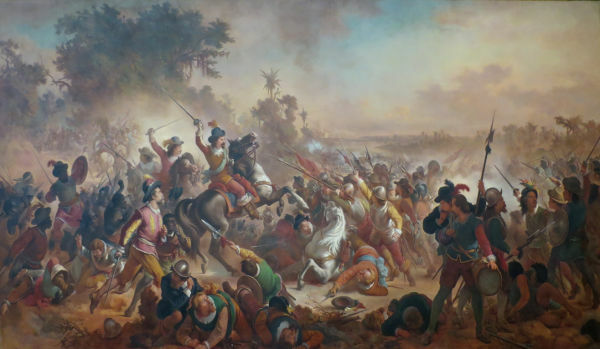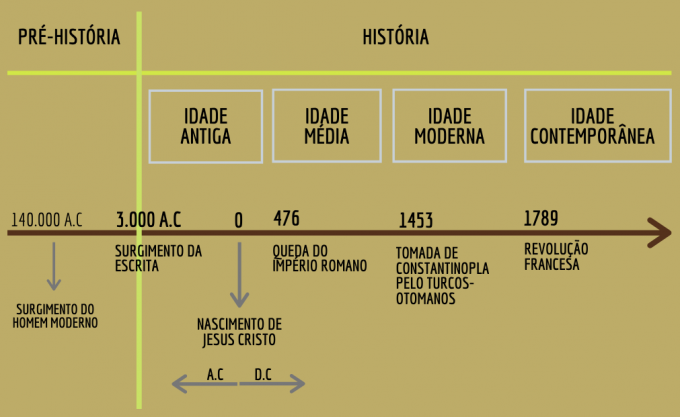At Dutch invasions in Brazil they happened in the first half of the 16th century, and through them the Dutch managed to establish a colony in the Northeast for 24 years. The Dutch invasions were motivated by the Dutch interest in taking control of the sugar business and because of the rivalry between Portugal and Holland, and this one with the Iberian Union.
During the 24 years of Dutch colonization, the great prominence was given through the administration of Mauritius of Nassau, appointed governor general of the colony in 1637. The domination ended in 1654, after Portugal and the colonists of Pernambuco mobilized to expel the Dutch from there.
Why did the Dutch invade Brazil?
The invasion of northeastern Brazil by the Dutch is related to the diplomatic relations involving Portugal, Spain and the Netherlands. It can be said that the fundamental event for this was the Iberian Union, unification of the Spanish and Portuguese crowns that lasted from 1580 to 1640. This union was a consequence of the succession crisis that hit the Avis dynasty at the end of the 16th century.
Also access:How the Avis dynasty was started in Portugal
Before understanding the relationship of the Dutch invasions with the Iberian Union, it is necessary to understand the diplomatic relations that existed between Portugal, Spain and the Netherlands. First, we must point out that the sugar business it was a very profitable economic activity and involved a partnership between the Dutch and the Portuguese.
The sugar business was set up in Brazil with the help of Dutch capital, as many planters were only able to develop their business with money borrowed by the Dutch.In addition, the Netherlands participated in the refining of sugar and its distribution throughout Europe. Thus, the Dutch had a relevant participation in this activity.
The Dutch, however, had been at war with the Spaniards since 1568. The conflict was motivated by those seeking to gain their independence from the Habsburgs, the royal family that ruled Holland, Spain and elsewhere in Europe. So we realized that Holland had relationsgood with Portugaland bad with Spain.
All that changed with the Iberian Union. In 1578, d. Henrique, king of Portugal, died and left no heirs to the Portuguese throne. Thus, three postulants who were related to him applied for the right to occupy the throne of Portugal. The victor in this scenario was Philip II of Spain, the Spanish king.
See more:The first sugar plantations in Brazil
With the coronation of Philip II, the throne of Portugal was occupied by the same king who ruled Spain, resulting in the unification of the two crowns. Thus, the Portuguese territory and all its colonies were linked to Spain, and its enemies became the enemies of Portugal.
With this reconfiguration (Portugal under the domain of Spain), the partnership between the Portuguese and the Dutch in the marketing of sugar was affected, and these were excluded from the activity. Filipe II even ordered the confiscation of Dutch vessels that had been in Lisbon for several years. The Dutch, then, decided to react to defend their economic interests.
In 1595, Dutch ships sacked the Portuguese port in São Tomé and Príncipe, on the African coast. From the 17th century onwards, in addition to attacking the Portuguese in Africa, they decided to attack the Portuguese colony in northeastern Brazil, starting the Dutch invasions in Brazil.
Dutch invasions in Brazil
O first attack Dutch came up against the city of savior, first capital of Brazil, in 1604. The aim of the Dutch was to conquer the capital, but they failed. After that, between 1609 and 1621, Portugal and Holland maintained a truce, but from 1621 onwards, hostility between the two countries returned.
In 1621, the Dutch founded the West India Company (West-Indische Compagnie, in Dutch), company responsible for the development of a Dutch colonial enterprise in the Americas. O big goal that company was to control the production of sugar in Brazil and the posts of slave trade in Africa.
With that on the horizon, the first dutch invasion was held in 1624. On that occasion, the Dutch turned again against Salvador, managing to conquer the cityafter 24 hours of battle. The Dutch stayed in the capital for a year and were never able to extend their domains beyond it.
The good men (who possessed social prominence and economic power) gathered on the outskirts of Salvador and impeded Dutch expansion. Reinforcements were sent from different Spanish domains and expelled the Dutch from Salvador in 1625. They they returned in 1627, but only to plunder the city.
Read too: Rio de Janeiro – second capital of Brazil
Invasion of Pernambuco

In 1630, the Dutch decided to focus against Pernambuco, another important sugar region in Brazil. This attack was, in large part, financed by withdrawals of the Dutch against the Spanish and the Portuguese, highlighting the theft of a Spanish fleet in 1628, which yielded a large fortune for the WIC (company's acronym in Dutch).
In 1630, the Dutch took more than seven thousand men to attack Olinda, city conquered on February 14 of that same year. After the conquest, they defeated the local resistance, which was still trying to repel the invaders, and transferred the capital to Recife, as it was easier to defend against.
The period from 1630 to 1637 is understood by historians as the conquest of the Northeast. During this period, the Dutch continually fought against the Portuguese and managed to extend their dominance of the Ceará to the São Francisco River. An important name for the Dutch victory was that of SundayFernandesCalabar, Portuguese who moved to the Dutch side.
From 1637 onwards, John Mauritius of Nassau (Johann Maurits van Nassau-Siegen in German) was appointed governor general of the Dutch colony in Brazil. Maurício de Nassau was a German who prospered as a military man in the Netherlands, being invited for his role as a military man and for having influential relatives.
Nassau, who remained here until 1643, carried out numerous important actions for the development of the Dutch colony. He sold abandoned plantations as a way of recovering the local economy, and ordered slave owners to plant cassava as a way to increase the colony's food supply.
Nassau also had great interest in science and arts, and therefore encouraged the arrival of Dutch and German artists and scientists to the colony. Several studies were conducted, and portraits by artists marked the Dutch view of 17th-century Brazil.
readmore: French invasions in Brazil, between 1500 and 1530
expulsion of the dutch

From the 1940s onwards, the West India Company filed forbankruptcy and the economy in Pernambuco faced a serious crisis. The WIC started to reinforce the collection of debts that sugar mill owners had, displeasing the lordly class, which started to strengthen the idea of restoration of the Portuguese.
Financial problems contributed to the strain of WIC's relationship with Mauricio de Nassau, and this resulted in the order of return from Nassau to Holland in 1643. In May 1644, Nassau finally returned to The Hague, the city where he lived before being sent to Brazil. His return coincided with the strengthening of the Portuguese, as a result of Restoration of 1640.
From that date onwards, the Portuguese crown was restored under the rule of the Braganças, and the idea of reconquering the Northeast began to be aired. The military forces of the Portuguese began to be strengthened, and resistance to the Dutch internally began to form. This resulted in the warsBrasilicas, started in 1645.
The Dutch in the Northeast lost a lot of strength when they were defeated in the Guararapes Battles, fought in 1648 and 1649, and saw their situation worsen when a war between Holland and England broke out in Europe. This further reduced the resources made available to the Dutch colony. Finally, in 1654, the Portuguese surrounded Recife and expelled the Dutch definitely. They also restored their rule to the colonies in Africa.
Image credits
[1]commons


